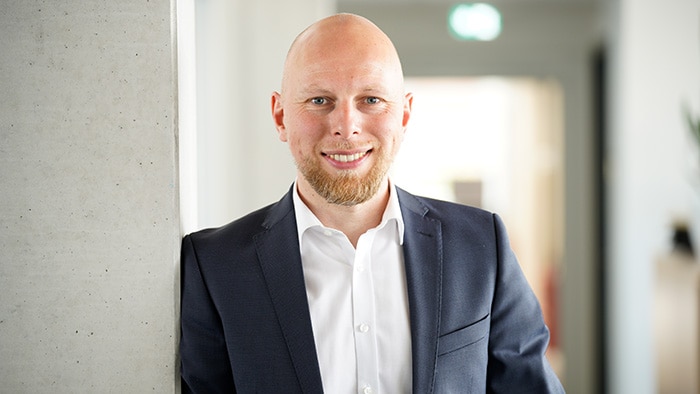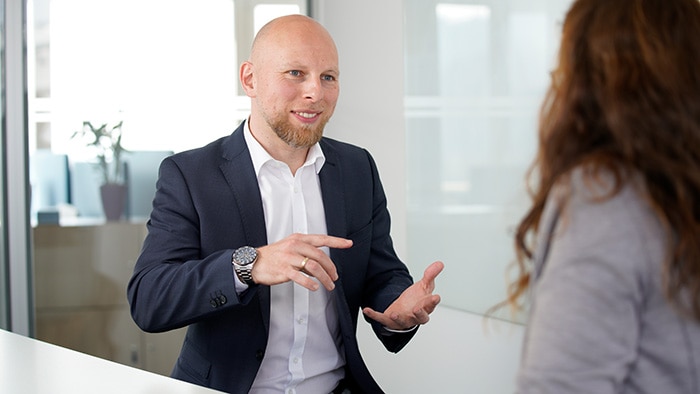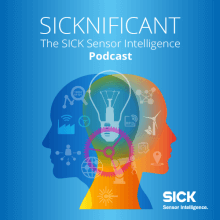Fabian Schmidt, Head of Digital Manufacturing at SICK, explains how, for him, a “growth mindset”, meaningful digitalization and delivering promised benefits are connected.
“Digital first” alone does not create added value
Is a mindset a driver or a brake? For Fabian Schmidt, this is a question of (corporate) culture. He differentiates between the “fixed mindset,” which is an entrenched way of thinking, and the “growth mindset,” which makes it possible to break new ground and venture into new territory. “For me, this also means that positive examples in our day-to-day work have much more impact than a top-down statement. Those who change their mindset only do so when they understand why that change is useful or necessary. This mindset also makes sense in terms of digital transformation: What can I do today to make things better in the future?” says the Head of Digital Manufacturing at SICK.
The Digital Manufacturing Team at SICK: Digital
solutions for the Intelligent Supply Network
Schmidt also sees his role in the team as exemplifying the “growth mindset”. At the beginning of 2021, the Digital Manufacturing Team was founded at SICK, which he heads together with Thomas Adolph. For him, the most important thing is a coherent vision: “As a team, we have to figure out where we want to go. Once we know that, we can create specific tasks. If the vision is too abstract or the overarching task is not linked to concrete steps, it is difficult to work toward it. Our central goal is the digital transformation of our global Intelligent Supply Network. This includes everything that is part of the production process: From raw material procurement to manufacturing to delivery. As a team, we focus on manufacturing, which is where we want to drive digitalization. We always start by asking the question: ‘What are the benefits we promise to deliver?’ Our mission is to find digital solutions for the Intelligent Supply Network and create a competitive advantage.”
Digital in production
For him, the buzzword “digitalization” is not just some unrealistic vision of the future, but a tangible, indispensable element in everyday life – as long as the benefits are clear. “The future may be vague, but you have to start somewhere. That’s why we have to make digitalization as tangible as possible. Our workers used to get their information printed out in a folder. They had to flip through pages and pages to get the information they needed. Today, this information is digital, so they don’t have to flip through pages anymore. But is that in itself added value? Added value is only created when I, for example, link the information to the work step currently being carried out; in other words, when I create a customized flow of information that saves time. Perhaps in the future, workers will wear smart glasses that project the instructions directly onto the work environment? Or maybe their role will change completely. Perhaps their job will be to monitor machines rather than do work themselves?”
Mastering complexity with the right information
Fabian Schmidt sees two developments that will influence the future world of work. Automation and digitalization will both lead to the elimination of work steps currently done by humans. “However, both factors also lead to increased complexity in the production environment; this results in more software and more machinery. And it must be possible to manage this complexity somehow. That’s why I don’t believe that humans will completely disappear from the factory environment. For the foreseeable future, the intelligence and creativity of humans are irreplaceable. They are the center of the whole. But it will become more important for them to be given the right information to master this complexity. For the time being, I personally don’t believe in the creation of a so-called super intelligence on par with humans – but there is a lot of debate on that.“
Digitalization with sound judgment
Schmidt also doesn’t believe in blanket statements like “digital first”: “The most important question is: What do you want to achieve? What sort of benefit do you want to create? The purely technology-driven approach that I have often seen in recent years doesn’t get us anywhere. Using a technology just because it exists doesn’t make any sense. Just because machine learning exists, for example, doesn’t mean it’s the best approach for my project. There might be a simpler, less expensive process that is a much better fit. If I commit to using a digital solution from the get-go, it could prevent me from ultimately finding the best solution.”
But how can you find out as quickly as possible which solution is the right one? To answer this central question, Schmidt and his team rely on a combination of flexible work processes and the Minimum Viable Product (MVP), which is an initial, minimally functional prototype of the solution or product. “If I want to get an improvement off the ground, I should be sure that it really is an improvement. That’s why I need to test my idea as early as possible.” Teams composed of members with different functions and an agile approach to work that brings together different types of technical expertise early on can help. “An interdisciplinary team has been created in the Digital Manufacturing Department. The production planners and software developers think about the same problem and always get different results. It’s faster and more innovative because they look at the issue from different points of view.“
Collaboration across different departments: “Everyone should understand what the others are doing.”
Approaches that result from the collaboration of flexible teams are often Minimum Viable Products. For Fabian Schmidt, this is the best way to quickly check whether a solution delivers its promised benefits in reality: “This is the smallest possible solution that we can take to the user. It is not yet a finished product. But with small feedback loops, we can quickly see whether we’ve followed the right hunch with an idea.” Fabian Schmidt also compares the MVP approach to the digitalization of manufacturing in an internal context: “When we talk about digitizing manufacturing, it’s essential to examine every digital change together with the people whose work it’s supposed to make easier. After all, they’re the experts. We will only gain a competitive advantage if we do this really well. Because of course everyone wants to improve their internal processes. In Digital Manufacturing, we’ve focused on really working across different departments. Everyone should understand what the others are doing. That’s the only way to create digital added value for the real world.“





